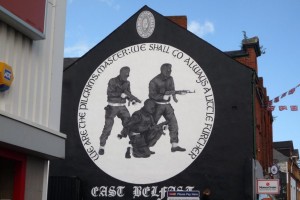The Murals of Northern Ireland and Movement Towards Peace

In a recent issue I explored the value of public art within the context of restorative mural arts projects in Philadelphia and the benefits such programs have within the community. In contrast, this edition will be focused on the murals of Northern Ireland that represent sectarian violence that spanned over thirty years. Rather than community improvement, these murals were done with the purpose of influencing political movements; there are over two thousand murals identifying either with the Nationalist and Republican supporters of the Irish Republican Army (IRA,mainly Catholic Irish nationalists) or the Unionist and Loyalist supporters of the Ulster-Defense Forces (UDF,who are primarily Protestant supporters of the throne). Both groups have a long history of violence and hatred stemming back to the seventeenth century, with the most recent historical violence in Northern Irish history known as the “Troubles”.
The use of murals for expression of political ideals began in 1690, after Protestant King William III defeated Catholic King James I. Although the original paintings did not survive, today in Derry, a mural from the 1920s is repainted every year by the UDF commemorating William’s victory. Murals that emerged during the 1960s picturing the Bloody Sunday shootings of Catholic rioters by British soldiers can be found throughout the county, with “Free Derry” being a regional slogan. They were created under the watch of armed guards in order to intimidate opponents waiting to deface the work once completed. Even in present day, the murals are used by members of the neighbourhoods as a form of identification, similar to that in Philadelphia. However, the drastic difference between those in Northern Ireland and those in Philadelphia is the purpose of creation and content. In Philadelphia, murals are used as a tool for restorative justice and depict major historical movements, colourful landscapes, and meditative designs. However, those lining the sides of rows houses along the streets of Belfast display intimidation, memorials of murdered individuals, and often gruesome reminders of the troubled past of religious conflict in Northern Ireland.
In recent years, a large debate within Northern Ireland was sparked as to whether action should be taken to preserve, replace, or remove the murals. Communities were deeply divided on the issue, with major concerns that loss of place and identity would result from new projects. In 2008, the formerly Loyalist paramilitary stronghold in the lower Shankill Road elected to replace ten sectarian murals with images of local sports figures. Assisting with this revitalization project was the Arts Council of Northern Ireland who allotted six million USD to create the Re-Imaging Communities and Building Peace Through the Arts programmes targeted at working with local areas to tackle the signs of sectarianism and racism. Their vision is to “place the arts at the heart of our social, economic and creative life.” Since their launch in February 2013, the programmes have enabled over forty-seven groups to consult with and engage the community as to how changes can be made within their communities. The feedback from the public has been very positive overall, with members engaging with local artists to create new pieces of artwork in areas that were previously stricken with violence. Sculptures and paintings of famous painters, writers, and musicians can now be found in community gardens, on street corners, and across the brick walls of town houses. Although murals still riddle the landscape of Northern Ireland, happiness is slowly spreading to communities looking to heal from a very violent past.
Travel Tip: If visiting Belfast or surrounding villages, tours are available year round to see the murals. They are usually by black cab, so ensure to book early especially if you have a big group! If you can’t make it to Belfast, check out a virtual Belfast mural tour at www.virtualbelfastmuraltour.com and www.belfast-murals.co.uk.
